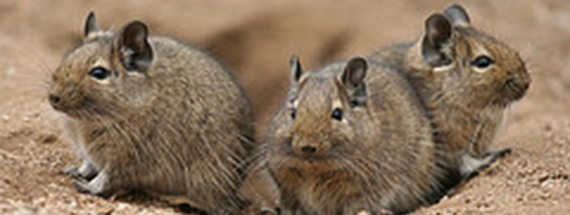Associations between habitat conditions, sociality, and brain organization in octodontid rodents.
2014

Both physical conditions of habitat and social environment are known to influence the size and organization of dentate gyrus (DG), yet the relative importance of these factors remains unclear. This study was aimed to resolve this question in two species of Chilean endemic rodents. We studied Octodon degus at two natural populations (Rinconada and El Salitre) and one population of O. lunatus that faced contrasting habitat conditions and differed in the extent of sociality.
We examined habitat conditions in terms of vegetation cover. The extent of sociality was inferred from quantifying group size and range area overlap. The brains and DG of male and female subjects with information on their habitat and sociality were examined. Habitat conditions differed among populations. The greater shrub cover lower rock cover in the habitat indicated spatial navigation based on distant and short-range visual cues is more challenging to O. lunatus. Female O. lunatus had larger brains than males, but not so in O. degus. Relative DG volume was similar across sexes and populations.
The right hemisphere of male and female O. lunatus had more cells than the left hemisphere, a DG directional asymmetry not found in O. degus. Group size was greater in O. degus from El Salitre. All together, degu population differences in brain size and DG cell number seemed more responsive to differences in habitat than to differences in social conditions. Within populations, large sized O. lunatus (but not O. degus from El Salitre) that ranged over larger areas and that were members of larger social groups had bigger brains. Large sized O. lunatus from Los Molles and O. degus from El Salitre that ranged over larger areas and were members of larger social groups had more DG cells. Thus, within population associations are consistent with a joint influence of habitat and sociality on brain size in O. lunatus, and on DG cell number in both O. lunatus and O. degus.

- Nombre: Raúl Sobrero Inverardi
- Laboratorio: Ecología Conductual
- Mención: Ecología
- Director Tesis: Luis Ebensperger
Artículos Publicados
1. Sobrero R, Inostroza-Michael O, Hernández CE, Ebensperger LA (2014) Phylogeny modulates the effects of ecological conditions on sociality across Hystricognath rodents. Animal Behaviour 94: 27–34
2. Sobrero R, Ly Prieto A, Ebensperger LA (2014) Activity, overlap of range areas, and sharing of resting locations in the moon-toothed degu, Octodon lunatus. Journal of Mammalogy 95: 91-98
3. Beery A, Kamal Y, Sobrero R, Hayes LD (2015) Comparative neurobiology and genetics of mammalian social behavior. in Sociobiology of caviomorph rodents: an integrative view (LA Ebensperger and LD Hayes, eds.). Wiley Blackwell.
